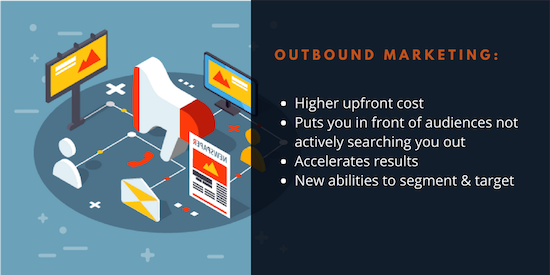
Over the last several years, outbound marketing has gotten a bad reputation. Most marketers are aware that 57% of the purchase decision is already complete before the customer calls a sales rep (CEB) and inbound marketing leads can cost up to 60% less than outbound leads (Hubspot). These two stats don’t put outbound marketing in the best light, and as such, the pendulum swung heavily towards inbound marketing over time.
However, outbound marketing in the digital world can play a crucial role in growing and accelerating pipeline in B2Bs. In part two of this three part series, we’ll take a look at what outbound used to be, how it has evolved in a customer-centric environment, and when B2B companies should implement outbound marketing tactics.
Missed part one? Check out: The Changing Face of Inbound Marketing
What was outbound marketing like 20 years ago?
Before the internet revolutionized the availability and delivery of content, marketers had to rely on wide-reaching, expensive tactics (sometimes referred to as “spray and pray”) to inform potential customers about services and products. Tactics like cold calling, television advertising, trade shows, direct mail, and others were commonplace.
There were major disadvantages to these tactics. Segmentation was pretty basic, campaigns had high costs, and there was virtually no accurate way to attribute results and calculate ROI.
The advent of inbound marketing was triggered by the incredible ability of internet connectivity and search engines to enable buyers to find information on their own. Once companies started to realize this shift in buying behavior, there began a massive wave in marketing strategy towards new inbound tactics like SEO, social promotion, and content marketing.
What is outbound marketing for B2B companies today?
Outbound marketing is a way to deliver marketing messages to consumers when they are not specifically searching for your content. Outbound allows you to put your message in front of audiences who aren’t aware of your business, who may have become unengaged with your company, or who aren’t aware of the problems you solve.
The digital era has brought new outbound channels like account-based advertising, social media ads, and “warm calling,” but traditional outbound tactics like direct mail and trade shows can be effective as well. The primary difference between outbound tactics today and those of the past is the ability to segment audiences. In all of these mediums, it is easier to identify segments that are more likely to be in need of your company’s solutions and promote messages to only those high-value segments. ROI reporting is also easier than in the past thanks to various tracking methods that can be deployed digitally.
When should you consider outbound marketing as a part of your strategy?
There are three primary reasons to consider implementing outbound tactics as part of your overall marketing strategy.
1. You have low awareness in your target market
Perhaps you’re launching into a new segment and have no brand awareness. Perhaps you solve a problem that most buyers aren’t even aware exists. Outbound provides a way for you to help potential clients begin their buyer journey. Content syndication in publications or resources heavily trafficked by buyers is a great example of effective outbound to generate awareness.
2. Inbound marketing doesn’t generate enough results
It is true that most buyers are performing research on solutions to their problems using search, but some buyers aren’t. B2B companies often have niche solutions for specific problems, and search volumes on relevant keywords may not be enough to drive consistent, quality results. These companies have an opportunity to divert some of their inbound resources to outbound tactics that can consistently get their message in front of the right personas.
The opposite could also be true for B2Bs in crowded markets. There may be a tremendous amount of search volume on relevant keywords, but those keywords and long-tail variations are owned by competitors with strong, historic inbound infrastructure in place. For these companies, the cost and effort necessary to beat competitors at inbound are high and long-term. Outbound, like PPC or paid social, helps focus resources on winnable channels that can provide return more quickly.
3. You have a complex purchasing cycle consisting of multiple buyers and multiple decision points
Many B2B companies operate with an account-based approach to marketing and sales. In this approach, the entire buying group within a target account is considered during program development. Outbound tactics like account-based advertising are excellent ways to build awareness with multiple buyers in the buying group without having to know each individual’s contact information.
We have one client, in particular, that is an excellent example of a B2B that has multiple of these challenges that can be addressed with outbound marketing. Our client helps large enterprises manage property tax expenses. Most companies in their target market have higher than necessary tax assessments on their commercial property but are unaware because property tax is not a typical line item actively managed by finance departments. They address an issue that (a) most buyers don’t know exists and (b) aren’t searching for on search engines.
After trying an inbound only marketing strategy for a few years, they were disappointed in the results. Even with expertly optimized content that was relevant to buyers, search traffic had not increased much, no leads had been generated or nurtured to opportunities, and organic growth was not sufficient to reach their goals. While inbound tactics are an important part of their marketing efforts, outbound tactics like content syndication, paid advertising, and account-based advertising are key to increasing awareness and demand for their services.

The Final Verdict
In many other resources on outbound marketing, you’ll find negative takes on outbound tactics. Outbound isn’t bad. It is a great compliment to integrated inbound marketing campaigns, and can help accelerate the positive effects of inbound marketing.





